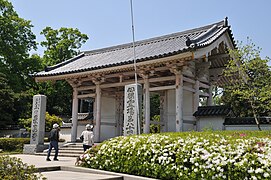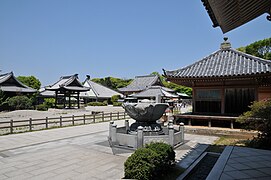Yashima-ji
The Yashima-ji ( Japanese 屋 島 寺 ), with the mountain name Nammenzan ( 南面 山 ) and the sub-temple name Senkōin ( 千 光 院 ), is a temple of the Shingon direction of Buddhism in the city of Takamatsu in Kagawa Prefecture . The temple on a hill on a headland on the eastern edge of the city is the 84th temple on the Shikoku pilgrimage route .
history
During the Nara period , the Chinese priest Jianzhen is said to have passed here on the way to Nara and built a small house ( 一 宇 Ichi-u ) on the north slope of the peninsula in which he made a sculpture of Fugen Bosatsu ( 普賢 菩薩 ) put up. In 816, Kūkai is said to have moved the place of prayer to the south side, where it is still located today. He is said to have set up a self-carved thousand-armed Kannon there. In the Middle Ages, the temple's importance declined, but it then received the support of the Ikoma and Matsudaira rulers there and flourished again.
The attachment
On the ascending path to the temple, one is greeted by the lower temple gate. The actual temple complex is reached through the Niō gate ( 仁王 門 Niō-mon ; 1) and arrives at the main hall ( 本 堂 Hondō ; 2). is. It has a floor plan of 5 × 5 Ken and is built in the "Japanese style" . It is one of the few buildings in the complex that date from the Kamakura period and is registered as an Important Cultural Property of Japan (marked with ◎ in the following). In 1618 it was first rebuilt in the style of the Azuchi Momoyama period , but when the building was dismantled for repairs in 1957, old components from the Kamaruka period were discovered and the decision was made to rebuild it in the old style. To the right of the Niō gate is the bell tower ( 鐘楼 Shōrō ; 3)
The temple area can also be reached through the "Great East Gate" ( 東 大門 Higashi Daimon ; 4). If you turn right north, you will see the Kantai-dō ( 干 躰 堂 ; 5), the Santai-dō ( 三 躰 堂 ; 6) and the Taishi-dō ( 大師 堂 ; 7) consecutively on the right side. and finally has to reach the Kumano-Gongen-Shrine ( 熊 野 権 現 社 -jinja ; 8) in front of him, to be reached by stairs .
Treasures of the temple
- A seated, thousand-armed Kannon (◎) made from a piece of oak is venerated . Stylistic features such as the shine ( 光 背 kōhai ) hands indicate that it was made in the early 10th century. The figure sits at rest, its robe is carved in a wave shape ( 翻 波 式Bampashiki ), which is typical of the Heian period.
- An old bell ( 梵 鐘 Bonshō ; ◎) hangs in the bell tower in front of the main hall . It is said to have been cast from bronze by the Igu method ( 鋳 繰 ) in 1233 by Renanmida-butsu ( 蓮 阿 弥陀 仏 ) , who lives in the province of Sanuki , to strengthen Buddhism .
- On the east side of the main hall are the raccoon dogs , venerated as Minoyama daimyōshin ( 蓑 山大 明 神 ) , once the "General of Shikoku" ( 四 国 の 大将Shikoku no taishō ), then the Tasaburō ( 太 三郎 ), who belongs to the "Three Great Raccoon Dogs of Japan" ( 日本 三大 狸 ) counts.
photos
Remarks
- ↑ The others can be found on the island of Sado or on the island of Awaji-shima .
literature
- Kagawa-ken no rekishisampo henshu iinkai (Ed.): Yashimaji . In: Kagawa-ken no rekishi sampo. Yamakawa Shuppan, 2013. ISBN 978-4-634-24637-9 . Pages 40 to 41.
- Oguri, Doei: Kukai. Shikoku hachijuhachi kosho no arukikata. Chukei no Bunko, 2011. ISBN 978-4-8061-4067-2 .
Web links
← Previous Temple: Ichinomiya-ji | Yashima-ji | Next temple: Yakuri-ji →
Coordinates: 34 ° 21 '28.5 " N , 134 ° 6' 4.5" E








